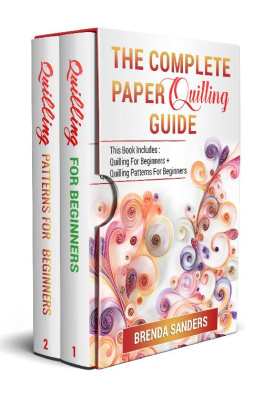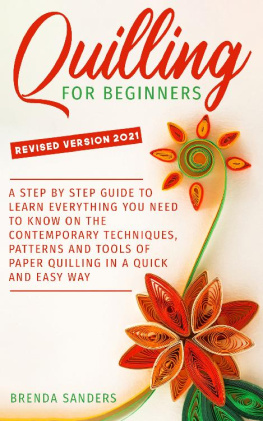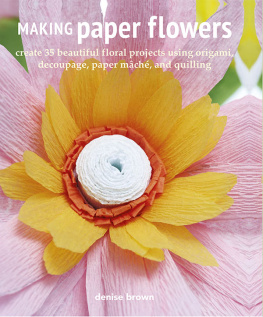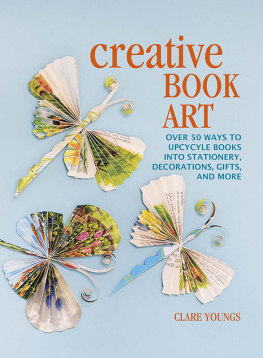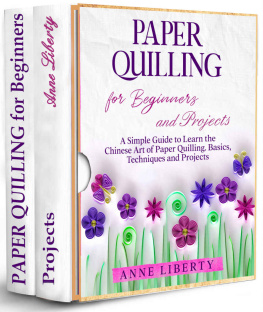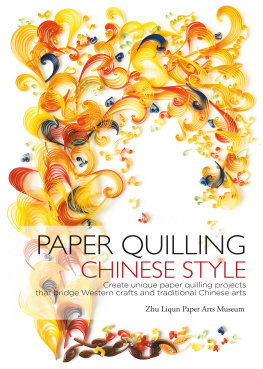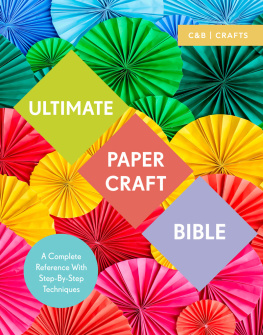THE COMPLETE
PAPER QUILLING GUIDE
by Brenda Sanders
A Step-By-Step Guide to Learn Everything You Need to Know On the Contemporary Techniques, Patterns and Tools of Paper Quilling In a Quick and Easy Way
by Brenda Sanders
Copyright 2021 by Brenda Sanders - All rights reserved
This book is targeted towards offering essential details about the subject covered. The publication is being provided with the thought that the publisher is not mandated to render an accounting or other qualified services. If recommendations are needed, professional or legal, a practiced person in the profession ought to be engaged.
In no way is it legal to recreate, duplicate, or transfer any part of this document in either electronic means or printed format. Copying of this publication is strictly prohibited, and its storage is not allowed unless with written authorization from the publisher. All rights reserved.
The information supplied herein is specified to be honest because any liability in regards to inattention or otherwise, by any use or abuse of any directions, processes or policies confined within is the sole and utter obligation of the recipient reader. Under no circumstances will any form of legal duty or blame be held against the publisher for any reparation, damages, or financial loss because of the information contained herein. The author owns the entire copyrights not held by the publisher.
The information stated herein is provided for educational purposes exclusively. The presentation of the data is without contractual agreement or any kind of warranty assurance.
All trademarks inside this book are for clarifying purposes only and are possessed by the owners themselves, not allied with this document.
Disclaimer
All erudition supplied in this book is specified for educational and academic purposes only. The author is not in any way in charge of any outcomes that emerge from using this book. Constructive efforts have been made to render information that is both precise and effective; however, the author is not to be held answerable for the accuracy or use/misuse of this information.
Foreword
I would like to thank you for taking the first step of trusting me and deciding to purchase/read this life-transforming book. Thanks for investing your time and resources on this product.
I can assure you of precise outcomes if you will diligently follow the specific blueprint I lay in the information handbook you are currently checking out. It has transformed lives, and I firmly believe it will equally change your life, too.
All the information I provided in this Do-It-Yourself piece is easy to absorb and practice.
Table of Contents
Introduction
Paper quilling is known as paper filigree. It can be defined as the art of rolling paper, especially when quilling it, folding it into diverse shapes and designs, pasting it on paper, and making a stunning three-dimensional piece of fine art. It is finished using slim portions of shaded papers, folded into a quilling needle, framing an ideal shape, and finally, the shapes are glued together to form objects.
It is an art highly known for its aesthetic purpose and is commonly used in making jewelry, fancy boxes, greeting cards, flowers for decorating walls, and much more. Lately, it has become a popular part of art gallery exhibitions.
The interesting thing is that you don't need to break your pocket to take up this hobby successfully. You need some basic supplies, but others can be improvised until you can afford them all. You could equally make do with some paper around you, cutting them into strips of paper for your project; this is if you can't access already cut paper strips.
The art includes loads of complex designs that could easily get you frustrated if you don't have the right materials or have knowledge of the basic shapes and how to make them. This book will guide you on the basic shape you need to begin with, and the complex shape you need to master. The starting point is the making of coils (closed and open) from where other shapes and designs surface. Once you've successfully learned this, your journey as a paper quiller begins, and with consistency, while trying out new projects, you'll find yourself at a professional level soon enough.
The origin of paper quilling as an art can be traced as far back as the 16th and 17th centuries. It is believed to have been practiced mainly by Italian and French nuns, whose love for decorating religious objects spurred them to find even better ways of doing so whilst saving the little money they had.
They made use of gold-gilded remnants of paper trimmed off in the process of making books, and this resulted in fine-gold quilled works at the time of emergence. This was a beautiful alternative to golden filigree, which was very expensive at that time, and so was not readily available.
The practice found footing in England in the 18th century with the development of paper, which was then accompanied by the use of vellum and parchment. The art soon became the favorite pastime of ladies who were often referred to as the "the ladies of amusement," a term used to point out ladies who had no house duties and equally had no inclination to take up jobs.
They would often make use of their created designs/quilled works to cover screens, tea-caddies, frames, etc. it soon became part of the curriculum in female boarding schools. It was not practiced then by working-class ladies as they saw it as an art of leisure. Eventually, it also sailed its ship into the United States of America, where it temporarily lost its voice to other more ancient hobbies, like knitting, sewing, painting, etc. The craft further gained footings across the Atlantic with the help of colonial masters who moved from countries to countries, their women bringing with them their favorite pastime routine of quilling.
Despite the odds faced centuries before, the art is now a well-celebrated part of the worlds creativity, and this is thanks to the ability to learn anything easily via social media and books. The popularity can also be attributed to its usefulness in children and adult craft, making it possible to keep kids creatively busy in schools and at home. And also, providing awesome pieces for decorating the kids' room, making gift-giving special in a different way, thus showing your loved ones how special and unique they are. Starting is pretty easy; as long as you are interested, you're ready to invest the time needed to learn and the basic materials.
There are a variety of ways to give life to your paper quilling ideas; the use of exceptional 3-dimensional designs is currently the way some unique paper crafters prefer to do their job, others prefer simple tilts towards the less-complex designs, preferring to make earrings, pendants, and others. For others, it is better viewed on canvas in art galleries, and yet others prefer the magnificence of museum walls for the exhibition of the work.
Regarding tools, a variety of simple and complex ones are available for purchase in the paper markets. Some, you can do without; others, you can improvise for. Either way, you won't have any issue sourcing for required materials as a beginner. It is equally advisable as a beginner to make do with the basic tools needed to learn, and then, as time goes on, you can further purchase more complex tools.
Paper quilling is a work of art that is finished by cutting paper into long strips and folding and cutting the pieces into various shapes and attaching them together to frame enhancing artistic ideas. When the paper is moved around a plume to make a basic curl shape, and then, attached at the tip, its basically known as paper quilling; these molded loops are organized to shape improving blossoms, cards and diverse fancy samples like ironwork.
The Importance of Paper Quilling
Next page
